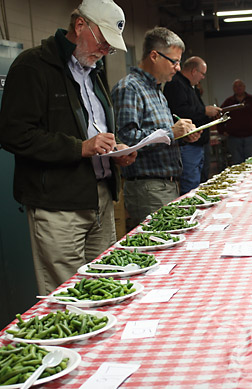Industry evaluates vegetables at NYSAES trials
By Kate Frazer

Students aren't the only ones being graded at the New York State Agricultural Experiment Station (NYSAES) this semester. Peas, snap beans and sweet corn were put to the test this month as 20 representatives from vegetable processing and seed companies visited the Geneva, N.Y., station to evaluate 160 veggie varieties grown in research trials there.
The objective of the trials was to find high-quality, high-yield and disease-resistant varieties adapted to the region's climate and soil conditions. But while agronomic data collected in the field provides critical data on crop performance, this postharvest sampling session gave industry representatives a firsthand chance to see, smell and taste the vegetables just as they will be when sent to market.
Displayed on checkered tablecloths, samples were cut into sizes commonly used by processors and were frozen or canned. To a layperson, the samples would look nearly identical, but the visiting reps knew how to pick out subtle differences.
"We all eat with our eyes," said James Ballerstein '86, a research specialist who has organized the annual event since 1996. "Much of it is about perception. Take green beans: We're looking for a dark green color -- but not too dark. A bean that's too close to black or grey could send the wrong message to consumers. And while a larger pea can be just as tender as a smaller one, consumers believe small size is an indication of tenderness so that's often preferred."
While these differences may seem inconsequential, they translate into real dollars for processors and seed companies. At the event, companies could identify quality problems unapparent in the field, compare their products with those of their competitors and pinpoint the most promising selections.
"It's a great way to sort out differences among varieties without planting a large acreage," said Roger Ward, a snap bean specialist with the western New York-based company Farm Fresh First. "Sometimes we land on a variety that becomes extremely successful. But it's equally important to identify those we don't want. That saves us from spending time and resources growing vegetables that won't be acceptable to customers."
Ballerstein recounted one snap bean cultivar that performed beautifully in the field, producing a good plant with high numbers of pods. But a piano string-sized string was found in the beans when they were processed for evaluation.
"Finding the string before the processor took the variety to commercial production saved them tens of thousands of dollars," Ballerstein said.
For 15 years, the open house has been as core part of the College of Agriculture and Life Sciences' commitment to helping farmers and food businesses generate profits through research. In New York state, vegetables grown for processing were valued at more than $27 million in 2011, and production totaled 113 thousand tons. NYSAES is unique in providing this scope of assistance. In turn, the seed companies and processors contribute about $100,000 a year to help fund the program.
"These days processing has to be competitive with fresh market," said Pieter Droegkamp, a seed salesman with Abbott and Cobb. "I'm looking for a product with a color, look and taste that's as close to fresh as possible."
According to Steve Reiners, professor of horticulture, who leads the field trials, canned and frozen vegetables sometimes get a bad rap.
"There's an assumption that fresh is more nutritious. But when you consider that fresh in the grocery story might mean it was harvested days or even weeks beforehand, a product that is picked and frozen within hours may actually be fresher."
Kate Frazer is a communications officer for the College of Agriculture and Life Sciences.
Media Contact
Get Cornell news delivered right to your inbox.
Subscribe